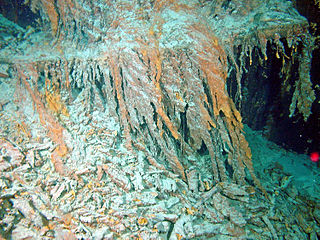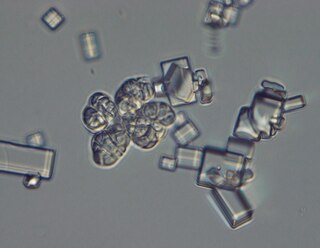Related Research Articles

Halomonadaceae is a family of halophilic Proteobacteria.
Halomonas venusta is a Gram-negative halophilic Proteobacteria, first described as Alcaligenes venustus and later reclassified as Halomonas venusta, along with other species when the genera Deleya, Halomonas, and Halovibrio and the species Paracoccus halodenitrificans were unified into a single genus, Halomonas, while the genus Zymobacter was placed in the family Halomonadaceae. The name stems from the Latin noun venusta which means "lovely" or "beautiful". It was originally isolated in marine water from Hawaii.
Halomonas nitroreducens is a Gram-negative halophilic Proteobacteria, that is able to respire on nitrate and nitrite in anaerobiosis.

Halomonas titanicae is a gram-negative, halophilic species of proteobacteria which was discovered on rusticles recovered from the wreck of the RMS Titanic. Cristina Sánchez-Porro et al. first isolated the bacterium in 2010 from a sample of rusticle obtained from the RMS Titanic in 1991. One of the researchers, Henrietta Mann has estimated that the action of microbes like Halomonas titanicae may bring about the total deterioration of the Titanic by 2030. While the bacteria have been identified as a potential danger to oil rigs and other man-made objects in the deep sea, it also has the potential to be used in bioremediation to accelerate the decomposition of shipwrecks littering the ocean floor.
Latilactobacillus sakei is the type species of the genus Latilactobacillus that was previously classified in the genus Lactobacillus. It is homofermentative; hexoses are metabolized via Glycolysis to lactic acid as main metabolite; pentoses are fermented via the Phosphoketolase pathway to lactic and acetic acids.
Alteromonas hispanica is a marine bacterium.
Deleya halophila is a salt-loving, gram-negative bacteria. It is known to habitat marine environments, solar salterns, saline soils, and salted food. The genus was named after J. De Ley, a noted biologist. Its type strain is CCM 3662.
Halomonas subglaciescola is a Gram-negative halophilic Proteobacteria. It was first isolated from an Antarctic, hypersaline, meromictic lake, but has since been found in other environments, such as fermenting seafood. It has a largely oxidative mode of metabolism and it is motile through peritrichous flagellation. This species doesn't utilise glucose, and its type strain is ACAM 12.

Wallemia ichthyophaga is one of the three species of fungi in the genus Wallemia, which in turn is the only genus of the class Wallemiomycetes. The phylogenetic origin of the lineage was placed to various parts of Basidiomycota, but according to the analysis of larger datasets it is a (495-million-years-old) sister group of Agaricomycotina. Although initially believed to be asexual, population genomics found evidence of recombination between strains and a mating type locus was identified in all sequenced genomes of the species.
Alcanivorax dieselolei is a species of alkane-degrading bacteria. Its genome has been sequenced. It is halophilic, aerobic, Gram-negative, non-spore-forming, catalase- and oxidase-positive, motile and rod-shaped. Its type strain is B-5T.
Chromohalobacter salexigens is a moderately halophilic species of bacteria. It was isolated from Bonaire, Netherlands Antilles The type strain is DSM 3043T. Its genome has been sequenced. It is a gamma-Proteobacterium, and as such, closely related to Pseudomonas and Escherichia coli.
Halomonas ventosae is a moderately halophilic, denitrifying, exopolysaccharide-producing bacterium. Its type strain is Al12T.
Marinobacter lipolyticus is a moderate halophile with lipolytic activity. It is Gram-negative and rod-shaped, with type strain SM19T.
Halobacterium noricense is a halophilic, rod-shaped microorganism that thrives in environments with salt levels near saturation. Despite the implication of the name, Halobacterium is actually a genus of archaea, not bacteria. H. noricense can be isolated from environments with high salinity such as the Dead Sea and the Great Salt Lake in Utah. Members of the Halobacterium genus are excellent model organisms for DNA replication and transcription due to the stability of their proteins and polymerases when exposed to high temperatures. To be classified in the genus Halobacterium, a microorganism must exhibit a membrane composition consisting of ether-linked phosphoglycerides and glycolipids.
Halomonas organivorans is a halophile able to degrade aromatic compounds. It's considered a potentially useful bacteria for decontamination of polluted saline habitats. Its type strain is G-16.1T.
Halomonas desiderata is an alkaliphilic, halotolerant and denitrifying bacterium first isolated from a municipal sewage works.
Halomonas alimentaria is a bacterium first isolated from jeotgal, a traditional Korean fermented seafood, hence its name. It is Gram-negative, moderately halophilic, non-motile and coccus- or short rod-shaped, with type strain YKJ-16T.
Halomonas hamiltonii is a halophilic bacteria first isolated from the environment surrounding dialysis patients. It is closely related to H. magadiensis.
Halomonas stevensii is a halophilic bacteria first isolated from dialysis patients and the environment surrounding them. Its genome has been sequenced.
Thalassobacillus is a Gram-positive and moderately halophilic genus of bacteria from the family of Bacillaceae. Thalassobacillus bacteria produces Meso-diaminopimelic acid.
References
- ↑ Martinez-Canovas, M. J. (2004). "Halomonas anticariensis sp. nov., from Fuente de Piedra, a saline-wetland wildfowl reserve in Malaga, southern Spain". International Journal of Systematic and Evolutionary Microbiology. 54 (4): 1329–1332. doi:10.1099/ijs.0.63108-0. ISSN 1466-5026. PMID 15280310.
- ↑ Tahrioui, A.; Quesada, E.; Llamas, I. (2013). "Draft Genome Sequence of the Moderately Halophilic Gammaproteobacterium Halomonas anticariensis FP35T". Genome Announcements. 1 (4): e00497-13–e00497-13. doi:10.1128/genomeA.00497-13. ISSN 2169-8287. PMC 3715671 .